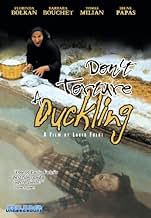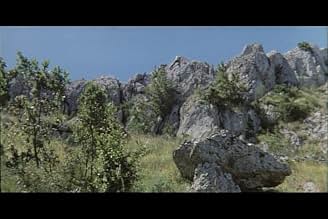VALUTAZIONE IMDb
7,0/10
11.920
LA TUA VALUTAZIONE
Un giornalista e una giovane donna promiscua cercano di risolvere una serie di omicidi di bambini in una remota città dell'Italia meridionale, piena di superstizioni e sfiducia nei confronti... Leggi tuttoUn giornalista e una giovane donna promiscua cercano di risolvere una serie di omicidi di bambini in una remota città dell'Italia meridionale, piena di superstizioni e sfiducia nei confronti degli estranei.Un giornalista e una giovane donna promiscua cercano di risolvere una serie di omicidi di bambini in una remota città dell'Italia meridionale, piena di superstizioni e sfiducia nei confronti degli estranei.
- Regia
- Sceneggiatura
- Star
Georges Wilson
- Francesco
- (as George Wilson)
Virgilio Gazzolo
- Police Commissioner
- (as Virginio Gazzolo)
Fausta Avelli
- Malvina
- (non citato nei titoli originali)
Gianfranco Barra
- Impallomeni
- (non citato nei titoli originali)
John Bartha
- Policeman
- (non citato nei titoli originali)
Empedocle Buzzanca
- Interrogation Officer
- (non citato nei titoli originali)
Recensioni in evidenza
I didn't know what to expect when I rented this widescreen DVD. I knew it had a cult following but I had also seen a lot of the director's later works which although delightfully gory were also pretty much incoherent. DON'T TORTURE A DUCKLING actually had a linear storyline and a mystery that kept me guessing almost until the end. And after all was said and done, it was a genuinely unsettling and creepy experience. One major caveat: I would much rather have heard the original soundtrack and read English subtitles than the uneven dubbing found here.
DON'T TORTURE A DUCKLING is one of Fulci's earlier (and honestly, in terms of story-line, better...) films - and although not the typical "bloodbath" that Fulci is known for - this is still a very unique and enjoyable film.
The story surrounds a small town where a series of child murders are occurring. Some of the colorful characters involved in the investigations - either as suspects, or those "helping" the investigation (or in some cases both) - include the towns police force, a small-time reporter, a beautiful and rich ex-drug addict, a young priest and his mother, An old man who practices witchcraft and his female protégé, a mentally handicapped townsman, and a deaf/mute little girl. All of these people are interwoven into the plot to create several twists and turns, until the actual killer is revealed...
DON'T TORTURE A DUCKLING is neither a "classical" giallo or a typical Fulci gore film. Although it does contain elements of both - it is more of an old-fashioned murder mystery, with darker subject matter and a few scenes of graphic violence (although nothing nearly as strong as some of Fulci's later works). This is a well written film with lots of twists that kept me guessing up until the end. Recommended for giallo/murder-mystery fans, or anyone looking to check out some of Fulci's non-splatter films - but don't despair, DON'T TORTURE still has more than it's fair share of violence and sleaze. Some may be put off by the subject of the child killings, and one main female character has a strange habit of hitting on very young boys, which is also kind of disconcerting - but if that type of material doesn't bother you, then definitely give this one a look. 8.5/10
The story surrounds a small town where a series of child murders are occurring. Some of the colorful characters involved in the investigations - either as suspects, or those "helping" the investigation (or in some cases both) - include the towns police force, a small-time reporter, a beautiful and rich ex-drug addict, a young priest and his mother, An old man who practices witchcraft and his female protégé, a mentally handicapped townsman, and a deaf/mute little girl. All of these people are interwoven into the plot to create several twists and turns, until the actual killer is revealed...
DON'T TORTURE A DUCKLING is neither a "classical" giallo or a typical Fulci gore film. Although it does contain elements of both - it is more of an old-fashioned murder mystery, with darker subject matter and a few scenes of graphic violence (although nothing nearly as strong as some of Fulci's later works). This is a well written film with lots of twists that kept me guessing up until the end. Recommended for giallo/murder-mystery fans, or anyone looking to check out some of Fulci's non-splatter films - but don't despair, DON'T TORTURE still has more than it's fair share of violence and sleaze. Some may be put off by the subject of the child killings, and one main female character has a strange habit of hitting on very young boys, which is also kind of disconcerting - but if that type of material doesn't bother you, then definitely give this one a look. 8.5/10
Lucio Fulci, later known for his graphic horror films like The Beyond and Zombie, was years earlier a master of the Italian giallo (in the company of Argento and Bava) with films like A Lizard In A Woman's Skin and his masterpiece, Don't Torture A Duckling. This film has all the elements of the Italian mystery/thriller genre known as the giallo, but really pulls the viewers in by having each key character with a skeleton in his/her own closet. This keeps you doing as much detective work as the detectives in the film itself. Who is killing the young boys in town? The young rich woman who is so bored that she sexually taunts the eventual victims, the reporter who likes to tamper with a crime scene to get a better photo shot, the townswoman with a mentally disabled daughter, the local witch, the town idiot....the list goes on, and you have to keep mental notes like a true game to play and solve. The themes in this film are very daring and done with that perfect Italian style in the early 1970s. It is certain that no American studio would have even considered making a film of such strong content, and that is precisely why this is such a satisfying film (despite some unusual accent choices for the dubbing for the English language version -- You'd do yourself a favor by watching it in its original Italian language, as that is how the actors spoke) and will definitely have people discussing its meanings long after viewing it. As the saying goes, they don't make them like this anymore, so get a copy and cherish an important film like this one!
In a small, idyllic village, far more is going on than meets the eye. When a local boy is found murdered, a suspect is quickly arrested. The police commissioner has serious doubts about the man they've put in jail. It's the second such killing, and it won't be the last.
Director Lucio Fulci's DON'T TORTURE A DUCKLING is a disturbing giallo, due to its subject matter. It is a tale of perversity, superstition / the occult, madness, and revenge. Packed with interesting characters, red herrings, mystery and suspense, this is one of Fulci's most satisfying thrillers.
Florinda Bolkan (A LIZARD IN A WOMAN'S SKIN) is perfect as the insane, shattered Maciara. Her beating is brutal today, and had to be extreme in 1972! Barbara Bouchet (THE FRENCH SEX MURDERS, THE RED QUEEN KILLS SEVEN TIMES) is also good as the VERY free-spirited, Patrizia. Though the bloody, final revelation is a tad overdone, it remains effective...
Director Lucio Fulci's DON'T TORTURE A DUCKLING is a disturbing giallo, due to its subject matter. It is a tale of perversity, superstition / the occult, madness, and revenge. Packed with interesting characters, red herrings, mystery and suspense, this is one of Fulci's most satisfying thrillers.
Florinda Bolkan (A LIZARD IN A WOMAN'S SKIN) is perfect as the insane, shattered Maciara. Her beating is brutal today, and had to be extreme in 1972! Barbara Bouchet (THE FRENCH SEX MURDERS, THE RED QUEEN KILLS SEVEN TIMES) is also good as the VERY free-spirited, Patrizia. Though the bloody, final revelation is a tad overdone, it remains effective...
I really enjoyed this film although I have only had a chance to watch it once. It's a great Giallo IMO and just as enjoyable as Fulci's later films. The direction was perhaps a bit rough around the edges but on the whole I thought the film worked really well and the ending was great (a real cliff hanger!). I thought one scene was particularly disturbing when the locals beat the hell out of a poor women while the radio played in the background. The inappropriate music made the images even harder to swallow but also gave the scene an emotional punch uncommon in a Fulci movie. I also felt that the story worked coherently and that the twist at the end was great. Fulci obviously has a rather low opinion of rural Italy's inhabitants because in this film all the villagers are presented as simpletons prone to mass-hysteria who live by their own backward laws (illustrated by the remorseless killing of the women) and religious beliefs.
Lo sapevi?
- QuizLucio Fulci was arrested on child endangerment grounds due to the infamous scene where a fully nude Patrizia (Barbara Bouchet) flirts with the underage Michele (Marcello Tamborra). The charges were dropped when Fulci explained that the actors' close-ups were filmed separately, and that the shot of Michele walking towards Patrizia with a pitcher and glass of orange juice was achieved by having an adult dwarf actor, Domenico Semeraro, stand in for Tamborra (if you look carefully, you will notice how different Semeraro's facial structure is from Tamborra's). Tamborra joked many years later that he wished he could have filmed that scene. But his parents wouldn't even let him see the film until he turned 15.
- BlooperAt one point during the fight scene between Martelli and Don Alberto near the end, the camera's shadow can briefly be seen on the ground.
- Versioni alternativeThe Anchor Bay release is the complete, uncut version of the film.
- ConnessioniFeatured in Innocence Lost (2015)
- Colonne sonoreQuei giorni insieme a te
Lyrics by Jaja Fiastri (uncredited)
Music by Riz Ortolani (uncredited)
Performed by Ornella Vanoni
I più visti
Accedi per valutare e creare un elenco di titoli salvati per ottenere consigli personalizzati
- How long is Don't Torture a Duckling?Powered by Alexa
Dettagli
- Data di uscita
- Paese di origine
- Lingua
- Celebre anche come
- Don't Torture Donald Duck
- Luoghi delle riprese
- Monte Sant'Angelo, Foggia, Apulia, Italia(the town of Accendura setting)
- Azienda produttrice
- Vedi altri crediti dell’azienda su IMDbPro
Contribuisci a questa pagina
Suggerisci una modifica o aggiungi i contenuti mancanti

































